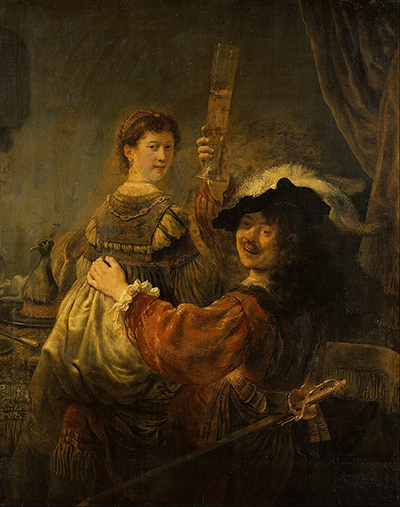The Prodigal Son would be a common theme within Rembrandt van Rijn's career, most famously with his Return of the Prodigal Son from 1669
This particular painting can be found in the Gemäldegalerie Alte Meister in Dresden and captures Rembrandt with his wife, Saskia. The artwork was completed around 1637, many years before his more famous Return of the Prodigal Son masterpiece. There were also related work in other mediums too, such as drawings and etchings.
The original painting can be found at the Gemäldegalerie Alte Meister in Dresden, Germany. This institution holds some highly significant contributions to European art history, including work by the likes of Raphael, Titian, Giorgione, Correggio, Tintoretto and Guercino.
Rembrandt's career has become one of the most researched of any artist in the world, with scientific techniques used relatively recently in order to confirm accurate attributions of paintings linked to his own work and also that of his studio. Findings produced on this artwork have revealed that the oils used included baroque pigments such as red ochre, madder lake, lead-tin-yellow and smalt which were common in the Baroque art movement.
This artwork was cropped down to its current size of 161 cm × 131 cm in order to avoid any distractions away from the main focal point. Rembrandt did this to several of his paintings over his career though normally because they were simply too big to find buyers. The larger previous version of this painting is believed to have included additional figures beyond just the two left remaining today.
The Prodigal Son is a religious narrative which helps to strengthen the moral backbone provided by Christianity. Both the artist and his wife were committed Christians and commonly sought to convey such messages through his work. Besides the moral themes, many of the biblical characters provided inspiring stories to artists, whether they were believers or not.
This humorous scene captures the artist swigging away with a flagon of ale whilst his wife sits playfully on his knee. It is possible that the couple were self-criticising through their depictions here, suggesting they would require later repentance for their supposed misdemeanors. This painting also offers an interesting view in their own lives, with Saskia comfortable in sitting for this less-than-complementary theme.
Perhaps she felt that all of the shame would lie on her husband, playing the prodigal son himself. The element of role play also can help people to distance themselves from their normal fears or concerns.




